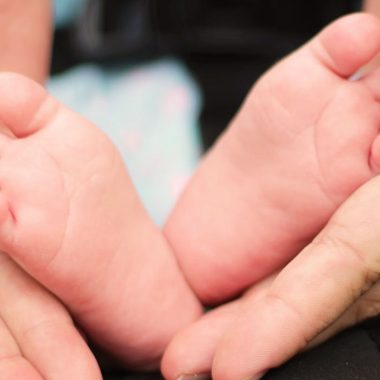Neonatal jaundice is a common condition that afflicts newborns.
About 6 out of 10 babies are born with signs of neonatal jaundice. Premature babies are more prone to the condition taking that number to 8 out of 10.
The primary cause of newborns’ jaundice is high bilirubin levels in the blood. Owing to the premature condition of the baby’s liver, it cannot effectively remove the excessive bilirubin.
As the liver develops and matures, it breaks down the bilirubin and sends it to the intestines. When this process starts, jaundice goes away.
This goes to show that neonatal jaundice is not a permanent condition. However, it is crucial to take the necessary measures promptly.
ALSO READ: Does My Baby Have Special Needs?
Getting a professional opinion and taking your little one to a pediatrician is highly recommended. It is also worth noting that your baby’s first few days following birth are crucial.
You need to ensure that your baby is fed well and frequently to provide them with the necessary nutrients for healthy development.
Table of Contents
What does neonatal jaundice look like?
If you are looking for telltale signs or symptoms to determine if your newborn has jaundice, some important signs and symptoms are:
- dark urine
- yellow skin
- pale poop
- yellow eye whites
The symptoms of jaundice in infants usually appear two days after birth. In most cases, around the two weeks mark, these symptoms disappear on their own.
In most cases, your baby is inspected for jaundice 72 hours after birth. This is a normal part of the regular checkup that a newborn goes through.
What is neonatal jaundice?
Simply put, neonatal jaundice is the term given to jaundice in newborns. It is a health condition that arises when bilirubin levels increase in the blood.
Bilirubin is a yellow-colored pigment found in the blood and formed in the liver. It is caused by the breakdown of hemoglobin and is excreted in the bile.
Some important facts to note about neonatal jaundice are:
- Neonatal jaundice usually sets in 2-3 days after birth
- Babies are checked for the condition 72 hours after birth as part of their regular checkup
- This condition usually lasts up to 2 weeks before it disappears on its own
- It is a common condition that affects 6 out of 10 newborns
- Babies born before 38 weeks are more prone to the condition
- The condition affects premature babies more often (8 out of 10 contract jaundice)
- A common sign of jaundice is the yellowing of the skin and eyes
It is important not to diagnose your baby without consulting a doctor. If you have doubts, schedule an appointment with your pediatrician.
Your doctor will be able to give you a proper diagnosis and guide you on how to proceed.
In most cases, jaundice in infants goes away on its own. That is why you must consult your doctor regarding your baby’s condition.
It is quite rare for newborns to require medication for neonatal jaundice.
What is bilirubin?
Bilirubin is the substance responsible for neonatal jaundice. It is formed when red blood cells are broken down.
Higher levels of bilirubin indicate malfunctioning in the liver.
Normally, the liver processes bilirubin and sends it to the intestines. From there, it is excreted from the body.
When a baby is still in the womb, the environment has far lower oxygen levels than when they are born.
Due to the lower oxygen levels, the fetus requires more hemoglobin to transport oxygen to the tissues.
This is why babies are born with higher hemoglobin levels in their system.
Once exposed to air with sufficient amounts of oxygen, the baby’s body no longer needs the same high levels of hemoglobin.
At this point, the hemoglobin is broken down – yielding bilirubin.
This is where things get a bit tricky. Due to the baby’s liver not being fully developed or mature yet, the bilirubin is not flushed out at the same rate that it is produced.
Hence, bilirubin starts accumulating in the blood – resulting in neonatal jaundice.
It takes the baby a few days after birth for their liver to start working properly.
Within the first 24 hours of a baby’s birth, bilirubin levels are typically 5.2 mg/dl.
Intervention is required if your baby’s bilirubin levels exceed 15 mg/dl within 25-48 hours after birth.
It is normal to observe bilirubin levels of 10-15 mg/dl in infants between 2-4 days old. This typically adjusts on its own without the need for external intervention or treatment.
A helpful chart used by the American Academy of Pediatrics for newborn jaundice levels can be seen below. This chart helps determine if a baby needs treatment.
Total serum bilirubin (TSB) level | Newborn's age |
Above 10 mg | < 24 hours old |
Above 15 mg | 24 - 48 hours old |
Above 18 mg | 48 - 72 hours old |
Above 20 mg | > 72 hours old |
ALSO READ: Toddler Cough Causes, Care and Remedies
Is my baby at risk for neonatal jaundice?
If your baby is exposed to certain factors, it can increase their chances of getting jaundice.
Some of the things that put your baby at a higher risk of getting neonatal jaundice are:
- Thyroid disorders or diabetes in the mother during pregnancy
- Different blood type than the mother’s
- Being born prematurely
- Difficult birthing conditions
- Impact such as bruising or pressing (particularly on the head)
- Not feeding properly due to weak sucking
- A family history of jaundice in older siblings
You should not be alarmed or worried even if your baby is at a higher risk for neonatal jaundice.
As mentioned before, it is a highly common condition that mostly wanes on its own.
Different types of neonatal jaundice
Neonatal jaundice can be divided into two main types based on the severity of the condition: physiological jaundice and pathological jaundice.
The former contains a few distinct types of jaundice, whereas the latter stands alone. Essentially any type of jaundice that cannot be categorized as physiological or any of its subtypes is considered pathological.
Physiological Jaundice
This type of jaundice is the most common one. It occurs between 2-3 days after birth. It is caused by the temporary heightened bilirubin levels in the baby’s blood.
Physiological jaundice disappears on its own within 7-10 days after birth. Even though this condition wanes without external assistance, it is important to have a pediatrician closely monitor and check up on your baby.
Feeding your baby frequently helps their body remove excess bilirubin quicker.
In physiological jaundice, bilirubin levels peak around the 4th day and reduce by the 14th day.
Breast milk jaundice
Breast milk jaundice is tricky to classify. Instead of categorizing it under physiological or pathological, many prefer to label it as early onset or late onset.
Breast milk jaundice usually sets in later. The term might sound alarming, but it is important to understand that it is not harmful. Breast milk itself does not cause jaundice.
This condition manifests in healthy breastfed babies after 4-7 days of birth. It persists longer than physiological jaundice, sometimes lasting up to 8-12 weeks.
Typically, it resolves spontaneously without the need to discontinue breastfeeding.
Breastfeeding jaundice
Breastfeeding jaundice surfaces in the first 3 days of your baby’s life. It reaches its highest point within 5 to 15 days after birth and disappears by the 3rd week of life.
This is caused by insufficient intake or production of breast milk.
Infants suffering from breastfeeding jaundice usually exhibit weight loss and signs of mild dehydration during their first few days of life.
ALSO READ: Baby Teething Symptoms, Care and Remedies
Breast milk jaundice vs. breastfeeding jaundice
Breast milk jaundice and breastfeeding jaundice are separate conditions. These two should not be confused with one another.
Breast milk jaundice occurs due to certain substances in the mother’s milk.
Certain biochemical enzymes in the mother’s milk affect the baby’s liver’s capacity to excrete bilirubin. Babies with breast milk jaundice do not experience weight loss.
Breastfeeding jaundice has nothing to do with the content of the mother’s milk. It has everything to do with the inadequacy of feeding or supply.
Babies with breastfeeding jaundice experience weight loss.
Pathological jaundice
Neonatal jaundice that does not fall under any of the aforementioned categories is classified as pathological.
Pathological jaundice typically manifests in the first 24 hours after birth.
If jaundice persists for more than 2 weeks in normally delivered babies (and more than 3 weeks in prematurely delivered babies), it requires pathological examination.
This is the most serious type of jaundice in newborns.
Some of the important factors that contribute to pathological jaundice include:
- Difference in blood group between mother and infant
- Liver disease
- Developmental defects in the biliary tract
- Enzyme deficiencies
- Viral or bacterial infections
- Anomalies in the shape and/or function of baby’s red blood cells
- Infection in the baby’s blood
- Internal bleeding
- Bruising, straining, or pressure during childbirth
Pathological jaundice requires care and supervision by a specialist. In some cases, it could require hospitalization. It is important to diagnose and treat it early.
Early treatment prevents the onset of permanent effects.
Treating neonatal jaundice
Typically, neonatal jaundice does not require treatment. The symptoms subside on their own without any need for medication or specific treatment.
Symptoms usually last between 10 to 14 days, but in some cases, they can last longer.
Doctors usually do not resort to treatment options unless the baby’s blood exhibits significantly high bilirubin levels.
At that stage, there is a possibility for the bilirubin to pass into the brain. This can cause serious brain damage.
Typically, a doctor will follow two main courses of treatment to quickly reduce bilirubin levels in your baby.
These are:
- Exchange transfusion: This procedure involves the removal of your baby’s blood using a thin tube (also called a catheter) inserted in their blood vessels. This blood is then replaced with blood from a matching donor. Most of the times, babies respond well to this treatment method and can be discharged within a few days.
- Phototherapy: This treatment method involves the exposure of your baby to a particular type of light. This light is shone on your baby’s skin and it works by altering the form of bilirubin making it easier for the liver to break it down.
How can I help my baby with neonatal jaundice?
In most cases, you and your baby will be free to go home without needing treatment. In those cases, it is important to know what to do to best help your baby with neonatal jaundice.
Aside from scheduling regular examinations and follow-ups with your doctor, you can support your baby at home, too.
ALSO READ: When Do Babies Crawl?
Feed your baby frequently
Make sure that your baby is getting sufficient nutrition. You want to feed your baby 8 to 12 times in 24 hours.
It is important that your baby is sucking properly and ingesting a healthy amount of breast milk. While breast milk on its own does not break down bilirubin, it does help your baby’s body carry out the necessary functions to flush out excess bilirubin.
This is one of the easiest and fastest ways to reduce bilirubin levels in the system – by excreting it through urine or poop.
If you are facing issues with breastfeeding, you might want to consult a lactation specialist. Frequently feeding your baby and ensuring that they are sucking properly will assist your baby in overcoming neonatal jaundice quickly.
What questions to ask your pediatrician?
It is common to get worried and alarmed if your baby exhibits signs or symptoms of jaundice. This can be difficult and tricky for a parent, especially a new one.
If you notice that your baby has developed symptoms after you’ve left the hospital, naturally, you will need to know what to ask your pediatrician.
Some questions that will help you become informed about your baby’s situation are:
- How can I know if my baby has neonatal jaundice?
- Are there any complications that can arise?
- Does my baby need treatment?
- Can I administer any remedies at home?
- Is phototherapy harmful to my baby?
- How long will it take for my baby to get back to normal?
- Do I need to come in for a follow-up?
Knowing what to ask your doctor will help you navigate this situation better. It will also help you make informed decisions regarding your baby’s health.










